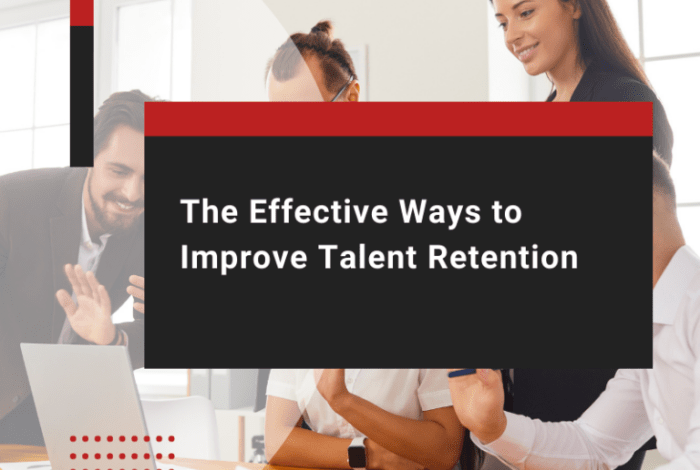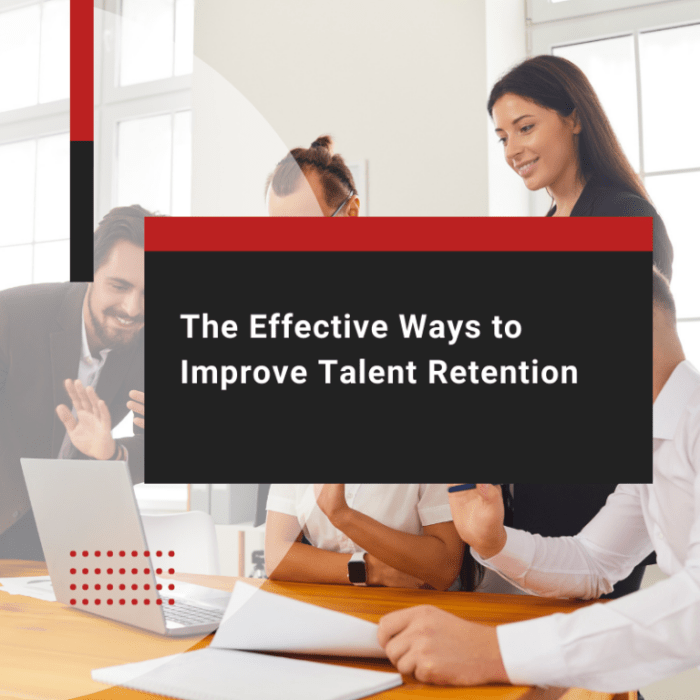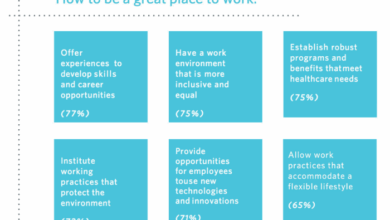
What is talent retention? It’s more than just keeping employees; it’s about creating a workplace where top performers thrive and want to stay. This involves understanding the factors driving employee loyalty and actively designing strategies to prevent valuable employees from leaving. From defining the concept to exploring effective retention strategies and measuring success, this in-depth look will provide insights into building a strong and sustainable workforce.
The importance of talent retention goes beyond simple employee satisfaction. A company that successfully retains top talent often sees improved productivity, reduced recruitment costs, and a stronger overall organizational culture. Understanding what drives employee loyalty is crucial for businesses aiming to thrive in today’s competitive market.
Defining Talent Retention
Talent retention is a critical aspect of human resource management focused on keeping valuable employees within an organization. It’s more than just preventing employee turnover; it’s about cultivating a work environment where employees feel valued, engaged, and committed to their roles and the company’s success. Effective talent retention strategies are crucial for maintaining a skilled workforce, fostering innovation, and ensuring business continuity.Talent retention differs from other HR practices like recruitment or performance management.
While recruitment focuses on acquiring new talent, and performance management aims to improve existing employee capabilities, talent retention is strategically geared towards keeping the best performers and most valuable employees. It involves understanding their needs, addressing their concerns, and providing opportunities for growth and development.
Importance of Talent Retention in Business
Talent retention is essential for sustained business success. A company with a strong talent retention strategy enjoys several advantages, including reduced recruitment costs, increased productivity, improved morale, and enhanced innovation. A stable workforce allows for smoother workflow, fewer disruptions, and a consistent application of skills and knowledge, directly impacting profitability and competitiveness.
Factors Contributing to Employee Retention, What is talent retention
Several factors contribute to employee retention. Compensation and benefits are fundamental, encompassing salary, health insurance, retirement plans, and other perks. However, a supportive and inclusive work environment plays a vital role. Opportunities for professional development, including training, mentorship, and advancement opportunities, are equally important. Recognition and appreciation, both formal and informal, are also powerful drivers of employee retention.
Talent Retention vs. Employee Turnover
Talent retention focuses on proactively preventing employees from leaving, while employee turnover is a measure of the rate at which employees leave an organization. High employee turnover can lead to decreased productivity, increased recruitment costs, and a loss of institutional knowledge. Talent retention aims to mitigate these risks by fostering a positive work environment and ensuring employees feel valued and challenged in their roles.
Effective talent retention strategies can significantly lower turnover rates and create a more stable workforce.
Talent Retention Strategies
A comprehensive talent retention strategy encompasses a variety of approaches, tailored to address specific needs and challenges. The following table provides a glimpse into diverse strategies.
| Strategy | Description | Example |
|---|---|---|
| Competitive Compensation and Benefits | Offering salaries and benefits that align with market standards and attract top talent. | Implementing a performance-based bonus system, increasing health insurance contributions, and offering flexible work arrangements. |
| Career Development Opportunities | Providing training, mentorship, and advancement opportunities to help employees grow within the company. | Offering internal training programs, providing opportunities for cross-functional projects, and establishing clear career paths. |
| Recognition and Appreciation | Recognizing and rewarding employees for their contributions and achievements. | Implementing employee recognition programs, celebrating milestones, and acknowledging outstanding performance. |
| Strong Company Culture | Creating a positive and inclusive work environment that fosters a sense of belonging and purpose. | Encouraging teamwork, promoting open communication, and fostering a culture of respect and trust. |
| Flexible Work Arrangements | Offering flexible work options, such as remote work or flexible hours, to accommodate employees’ needs. | Implementing remote work policies, allowing flexible work schedules, and providing on-site childcare facilities. |
Strategies for Talent Retention
Attracting and retaining top talent is crucial for any organization’s success. A strong talent retention strategy not only reduces recruitment costs but also fosters a culture of loyalty and productivity. Companies that prioritize employee well-being and growth often see higher retention rates and increased profitability.Effective talent retention strategies are multifaceted, encompassing various approaches from recognizing employee contributions to fostering a positive work environment.
A comprehensive approach considers the needs and motivations of employees, leading to a more engaged and productive workforce.
Employee Recognition Programs
Employee recognition programs are vital for fostering a positive work environment and boosting employee morale. These programs can take various forms, from simple thank-you notes to formal awards ceremonies. Recognition programs not only acknowledge employee contributions but also motivate them to continue performing at a high level. They demonstrate a company’s appreciation for its employees, fostering a sense of value and belonging.A well-designed program should be specific, timely, and meaningful.
Recognition should be linked to specific achievements and behaviors, ensuring that it is seen as a genuine expression of appreciation. For example, a company might implement a “Employee of the Month” program, or a system for peer-to-peer recognition. These programs can be tailored to the company culture and employee preferences.
Professional Development Opportunities
Providing opportunities for professional development demonstrates a company’s commitment to employee growth and advancement. This can take many forms, including training programs, mentorship opportunities, conferences, and tuition reimbursement. Employees who feel supported in their professional development are more likely to be engaged and committed to the organization. They are more likely to see their career progression within the company, reducing the desire to leave for other opportunities.Companies that offer robust professional development often see a significant reduction in employee turnover.
Investing in employees’ future demonstrates that the company values their contributions and is committed to their long-term success. This fosters loyalty and strengthens the employee-employer relationship.
Competitive Compensation and Benefits Packages
Competitive compensation and benefits packages are essential for attracting and retaining top talent. A comprehensive benefits package should include competitive salaries, health insurance, retirement plans, paid time off, and other perks. A strong compensation and benefits package demonstrates that the company values its employees and recognizes their contributions.Consider external market data when evaluating compensation. This ensures that salaries and benefits are competitive in the industry.
For instance, conducting regular salary surveys can help companies stay informed about industry trends and ensure that their compensation packages remain competitive. This competitive edge helps attract and retain top talent.
Positive Work Environment
A positive work environment is crucial for employee retention. A positive environment fosters collaboration, trust, and respect. It promotes open communication, encourages employee feedback, and recognizes the importance of work-life balance. A positive work environment leads to increased job satisfaction and a stronger sense of belonging.Companies that prioritize a positive work environment often experience lower turnover rates.
They create an environment where employees feel valued, supported, and motivated to contribute to the organization’s success. For example, companies can implement flexible work arrangements, promote team-building activities, and foster a culture of inclusivity.
Company Cultures Fostering Employee Loyalty
Companies with cultures that foster employee loyalty often emphasize values like trust, respect, and open communication. They create a sense of community and belonging, where employees feel heard and valued. These companies invest in employee well-being and recognize the importance of work-life balance. A culture that prioritizes employee well-being leads to greater employee satisfaction and loyalty.Examples include companies that celebrate milestones, organize social events, and create opportunities for employees to connect with each other outside of work.
These activities demonstrate a genuine commitment to employees’ overall well-being, contributing significantly to a positive work environment and loyalty.
Comparing Retention Strategies
| Strategy | Description | Advantages | Disadvantages |
|---|---|---|---|
| Employee Recognition | Acknowledging and rewarding employee contributions | Boosts morale, fosters appreciation, motivates performance | Requires consistent effort, potential for bias |
| Professional Development | Providing training and growth opportunities | Increases skills, improves employee engagement, enhances loyalty | Can be costly, requires time commitment |
| Competitive Compensation | Offering market-competitive salaries and benefits | Attracts top talent, demonstrates value to employees | Requires careful market analysis, potential for cost increases |
| Positive Work Environment | Creating a supportive and inclusive workplace | Enhances job satisfaction, improves collaboration, fosters loyalty | Requires cultural shift, can be challenging to implement |
Measuring Talent Retention
Understanding how effective your talent retention strategies are is crucial for continuous improvement. Quantifying the impact of these initiatives allows for data-driven adjustments and demonstrates the return on investment (ROI) of your efforts. Without measurable results, it’s difficult to identify what’s working and what needs refining. This crucial step allows organizations to fine-tune their approach and ensure they’re achieving optimal outcomes.Accurate measurement provides insights into employee satisfaction, engagement levels, and turnover rates.
Talent retention is all about keeping your best employees happy and engaged. It’s a crucial aspect of any successful business, especially when companies like Google are pushing the boundaries of innovation, like in their seemingly bright future with smart shades. Google sees a bright future in smart shades , and that kind of forward-thinking innovation could inspire employees to stay.
Ultimately, effective talent retention strategies are key to fostering a thriving and productive workforce.
This, in turn, helps pinpoint areas for improvement and tailor strategies for maximizing employee retention. Using data to guide decisions ensures resources are allocated strategically, leading to more effective and sustainable retention programs.
Quantifying the Effectiveness of Talent Retention Initiatives
Effective measurement of talent retention initiatives involves several key performance indicators (KPIs). These KPIs provide a comprehensive view of the success of the implemented strategies. Collecting and analyzing data associated with these metrics allows for the identification of strengths and weaknesses within the talent retention strategies.
Metrics for Evaluating Employee Satisfaction and Engagement
Employee satisfaction and engagement are crucial factors in talent retention. Measuring these factors provides insight into employee well-being and their commitment to the organization. Tools like employee surveys, feedback mechanisms, and focus groups can gather valuable data to gauge satisfaction and engagement levels.
- Employee Surveys: Regular surveys can assess employee satisfaction with various aspects of their job, company culture, and management. These surveys can reveal areas needing improvement and provide a snapshot of the overall sentiment within the organization.
- Employee Net Promoter Score (eNPS): This metric gauges employee loyalty and their willingness to recommend the company to others. A higher eNPS score indicates a more positive employee experience and increased loyalty.
- Feedback Mechanisms: Establishing clear channels for employees to provide feedback on their experiences, such as suggestion boxes, online forums, or one-on-one meetings, can identify issues and foster a culture of open communication.
- Focus Groups: Gathering small groups of employees for focused discussions about specific issues or strategies can provide deeper insights into employee perspectives and opinions.
Methods for Tracking Employee Turnover Rates
Tracking employee turnover rates is essential for understanding the effectiveness of talent retention efforts. By analyzing the rate at which employees leave, organizations can identify patterns and implement targeted interventions. Calculating turnover rates requires meticulous data collection and analysis.
- Calculating Turnover Rate: The turnover rate is calculated by dividing the number of employees who left during a specific period by the average number of employees during that period, multiplied by 100. For example, if 10 employees left a company of 100 employees in a quarter, the turnover rate would be 10%. This metric is a key indicator of retention effectiveness.
- Identifying Trends: Examining turnover data over time reveals patterns and potential issues. Identifying trends, such as a spike in resignations during a specific quarter, allows for proactive responses and targeted solutions.
- Segmenting Turnover Data: Analyzing turnover rates by department, role, or tenure can pinpoint specific areas where retention strategies need adjustment. This approach enables a more focused and effective response to the problem.
Key Performance Indicators (KPIs) for Talent Retention
KPIs are essential for tracking and measuring the success of talent retention initiatives. These indicators provide a structured framework for evaluating the effectiveness of implemented strategies. Key metrics should be tailored to the specific needs and goals of the organization.
- Employee Satisfaction Scores: These scores, derived from surveys or feedback mechanisms, reflect the overall level of satisfaction employees experience in their roles and the organization.
- Employee Engagement Scores: These scores, often derived from engagement surveys, quantify the level of employee dedication and commitment to the organization.
- Employee Turnover Rate: This rate measures the percentage of employees who leave the organization within a specific timeframe.
- Time-to-Fill Rate: This metric reflects the duration it takes to find replacements for departed employees.
Table of Metrics Used to Measure Talent Retention Success
This table Artikels various metrics used to measure talent retention success. By tracking these metrics, organizations can identify areas needing improvement and adjust strategies accordingly.
| Metric | Description | How to Measure |
|---|---|---|
| Employee Satisfaction | Overall contentment with the job and company | Employee surveys, feedback forms, exit interviews |
| Employee Engagement | Level of commitment and involvement | Engagement surveys, focus groups, observation |
| Employee Turnover Rate | Percentage of employees leaving within a period | Divide departing employees by average headcount |
| Time-to-Fill | Time taken to find a replacement for an employee | Track time from vacancy to fill |
| Training Completion Rate | Percentage of employees completing training programs | Track training program completion |
Using Data to Improve Talent Retention Strategies
Analyzing data from various sources is crucial for identifying areas needing improvement. This allows organizations to adapt their strategies to address specific issues and enhance the employee experience. Regular reviews of the data help identify trends and implement changes as needed.
“Data-driven decisions are crucial for creating effective talent retention strategies.”
By continuously monitoring and analyzing data, organizations can proactively address challenges and optimize talent retention initiatives, leading to a more engaged and productive workforce.
Challenges in Talent Retention
Attracting and retaining top talent is crucial for organizational success. However, numerous factors can impede this process. Understanding these challenges is vital for implementing effective retention strategies. Businesses face a complex interplay of economic forces, industry trends, and internal dynamics that can significantly impact employee satisfaction and commitment.Effective talent retention strategies must proactively address these challenges, fostering a positive work environment and recognizing the value of employees.
Talent retention is all about keeping good employees happy and engaged. It’s a crucial aspect of any successful business, and in the ever-evolving world of tech, especially. Think about the innovative toy tech companies like those featured in the article “toy tech in search of the light app tastic” toy tech in search of the light app tastic.
They’re facing the same challenges – how to keep top engineers and designers from jumping ship to greener pastures. Ultimately, successful talent retention strategies are vital for long-term growth and innovation, no matter the industry.
A deep understanding of the factors driving employee departure is essential for proactive interventions.
Economic Conditions and Talent Retention
Economic downturns often lead to increased competition for available jobs, making it harder for companies to retain employees. During periods of economic uncertainty, employees may seek better compensation or job security elsewhere. Companies need to carefully analyze their financial situations and adjust their compensation and benefits packages to remain competitive. The recent economic recession, for instance, saw significant job losses and increased turnover in several industries.
Companies that successfully navigated this period often focused on providing stability and clear communication about the company’s future.
Industry Trends and Talent Retention
Rapid technological advancements and evolving industry standards create continuous challenges in talent retention. Employees need to adapt to new tools and technologies to stay relevant in their fields. Companies need to provide opportunities for professional development and upskilling to equip employees with the necessary skills for the future. The rise of remote work, for instance, has dramatically altered how companies interact with employees.
This necessitates adaptable policies and a culture that values flexibility and productivity outside traditional office hours.
Industry-Specific Talent Retention Challenges
Different industries face unique hurdles in retaining talent. For example, the tech industry is notorious for high employee turnover due to competitive salaries and rapid innovation. Software developers and engineers are often in high demand, making it challenging to retain them. The healthcare sector, on the other hand, often faces challenges related to burnout and long working hours, particularly for nurses and doctors.
These industry-specific challenges require tailored retention strategies that address the unique needs and motivations of employees within each sector.
Employee Burnout and Stress
High workloads, demanding deadlines, and a lack of work-life balance can contribute significantly to employee burnout and stress, ultimately leading to increased turnover. Burnout can manifest in reduced productivity, decreased job satisfaction, and ultimately, an employee’s decision to seek employment elsewhere. Companies must prioritize employee well-being by implementing policies that promote work-life balance, encourage breaks, and offer mental health resources.
Promoting a supportive and understanding work environment, fostering open communication, and providing resources to manage stress are crucial.
Common Challenges and Potential Solutions
| Challenge | Potential Solution |
|---|---|
| Economic downturn | Competitive compensation and benefits packages; clear communication about the company’s future; financial stability measures. |
| Industry trends | Professional development opportunities; upskilling programs; adaptable policies; flexible work arrangements. |
| Industry-specific demands (e.g., tech, healthcare) | Tailored compensation packages; specialized training; fostering a positive work culture; competitive benefits packages. |
| Employee burnout and stress | Prioritizing work-life balance; implementing policies that encourage breaks; providing mental health resources; supportive work environment. |
Creating a Culture of Retention
Cultivating a culture of employee retention isn’t just about offering competitive salaries and benefits; it’s about fostering a sense of belonging, purpose, and appreciation within the organization. A positive and supportive work environment significantly impacts employee loyalty and reduces turnover. This approach builds a strong foundation for long-term success, as happy and engaged employees are more likely to stay and contribute meaningfully to the organization’s growth.A strong retention culture is a proactive strategy that anticipates and addresses potential reasons for employee departure.
It goes beyond simply addressing immediate needs and focuses on building a sustainable environment where employees feel valued, supported, and motivated to stay long-term. This requires a deep understanding of employee needs and desires, as well as a commitment to continuous improvement in the work environment.
Talent retention is all about keeping your best employees happy and engaged. It’s a tricky business, though, especially when you see how frustrated customers can be with a company like Verizon, even after service issues like the recent 4G back up problems detailed in Verizon’s 4G service back up but users still miffed. Ultimately, it boils down to fostering a positive work environment and offering competitive compensation to keep those valuable employees.
Companies need to understand what motivates their employees to ensure long-term success.
Strategies for Building a Retention-Focused Culture
Creating a culture of retention requires a multi-faceted approach that goes beyond basic compensation. It involves actively fostering a positive work environment that supports employee well-being, growth, and connection to the organization’s mission.
- Open Communication and Feedback: Regular and open communication channels are crucial for employee engagement. This includes two-way feedback mechanisms, where employees feel comfortable sharing their thoughts and concerns, and the organization actively listens and responds. Creating an environment where feedback is valued, and implemented where appropriate, strengthens the trust and rapport between employees and management.
- Promoting a Sense of Belonging and Purpose: Employees are more likely to stay with organizations where they feel a sense of belonging and purpose. This involves fostering a sense of community and shared values. Recognizing and celebrating employee contributions, regardless of their role, is an essential element. Organizations should clearly communicate their mission and values and show how individual roles contribute to the overall success.
- Encouraging Collaboration and Teamwork: Collaborative work environments foster a sense of community and shared responsibility. Opportunities for teamwork, shared projects, and cross-functional interactions can strengthen relationships and promote a sense of shared purpose. Regular team-building activities can strengthen these bonds.
- Effective Employee Engagement Initiatives: Implementing employee engagement initiatives, such as skill-building workshops, mentorship programs, and social events, can foster a stronger sense of connection and belonging. These activities provide opportunities for employees to develop professionally, enhance their skills, and build relationships with colleagues.
Key Elements of a Retention-Focused Culture
A retention-focused culture encompasses several key elements that contribute to employee loyalty and engagement.
| Element | Description |
|---|---|
| Open Communication | Establishing clear communication channels, active listening, and a culture where feedback is valued. |
| Recognition and Appreciation | Acknowledging and celebrating employee contributions, fostering a sense of value and belonging. |
| Growth Opportunities | Providing opportunities for skill development, career advancement, and professional growth. |
| Work-Life Balance | Creating a flexible and supportive environment that respects employee well-being. |
| Strong Leadership | Effective leadership that inspires, motivates, and fosters a positive work environment. |
| Meaningful Work | Connecting employees to a larger purpose and demonstrating how their work contributes to the organization’s mission. |
Employee Value Proposition (EVP): What Is Talent Retention
Attracting and retaining top talent isn’t just about offering a competitive salary; it’s about crafting a compelling narrative that resonates with potential employees on a deeper level. This is where the Employee Value Proposition (EVP) comes into play. A well-defined EVP paints a vivid picture of what an organization offers its employees, going beyond the basic job description to encompass the entire employee experience.A strong EVP acts as a powerful magnet, drawing in talented individuals who align with the company’s values and culture.
It also fosters loyalty and reduces employee turnover, ultimately saving the organization significant time and resources in recruitment and training. A compelling EVP isn’t just a marketing slogan; it’s a genuine reflection of the employee experience and a crucial element in building a thriving and successful organization.
Defining the Employee Value Proposition
An EVP is a clear and concise articulation of the unique value an organization offers its employees. It goes beyond just compensation and benefits to encompass the entire employee experience, including the work environment, career development opportunities, company culture, and overall well-being. Essentially, it answers the question: “Why should someone choose to work here?” A strong EVP addresses the needs and aspirations of potential employees, showcasing the benefits of joining the company.
Developing a Compelling EVP
Crafting a compelling EVP requires a deep understanding of the target audience and their motivations. Researching the needs and expectations of potential employees is paramount. Understanding what motivates them – be it career advancement, work-life balance, or a sense of purpose – is crucial for creating a tailored EVP. This process involves internal surveys, focus groups, and analysis of market trends to determine what resonates with potential candidates.
A well-defined EVP will highlight the unique benefits and advantages of working at a particular company.
Examples of Successful EVPs
Several companies have successfully implemented compelling EVPs. For instance, Google’s EVP emphasizes a collaborative work environment, opportunities for growth, and a focus on employee well-being. This includes perks like free meals, on-site gyms, and flexible work arrangements, all contributing to a positive and productive work environment. Similarly, companies like Patagonia emphasize environmental responsibility and social impact, appealing to environmentally conscious employees who seek to contribute to a cause larger than themselves.
Comparing EVPs Across Industries
EVPs differ significantly across industries. Tech companies often emphasize innovation, creativity, and cutting-edge technology, while healthcare organizations focus on making a difference in people’s lives, offering supportive work environments, and a sense of community. Financial institutions might highlight stability, security, and professional development opportunities. Understanding these nuances is critical to crafting an EVP that resonates with the specific needs of potential employees within each sector.
Elements of a Strong EVP
A robust EVP resonates with potential employees on multiple levels. It includes factors such as competitive compensation and benefits packages, opportunities for professional growth and development, a supportive and inclusive work environment, a strong company culture, and a clear sense of purpose and mission. The company’s values and ethical standards should also be reflected in the EVP.
Key Components of a Robust EVP
| Component | Description |
|---|---|
| Compensation & Benefits | Competitive salary, comprehensive benefits package, performance-based incentives, and other perks. |
| Work Environment | Flexible work arrangements, a supportive and inclusive atmosphere, opportunities for collaboration, and a comfortable and well-designed workspace. |
| Career Development | Mentorship programs, training and development opportunities, clear career paths, and chances for advancement. |
| Company Culture | A strong sense of community, shared values, and a positive work environment that fosters collaboration and employee well-being. |
| Purpose & Mission | A clear sense of purpose, aligning with the company’s mission and values. This is especially attractive to employees who want to contribute to something meaningful. |
Employee Engagement

Employee engagement isn’t just a buzzword; it’s a critical factor in building a thriving workplace. Highly engaged employees are more productive, more committed, and more likely to stay with a company long-term. Understanding how to foster engagement is key to successful talent retention strategies.Engagement goes beyond simply being satisfied with your job. It’s about feeling a sense of purpose, connection, and enthusiasm towards your work and the organization.
This translates directly into increased output and overall organizational success.
Importance of Employee Engagement in Talent Retention
High levels of employee engagement are directly correlated with lower turnover rates. When employees feel valued, respected, and connected to the company’s goals, they are more likely to remain loyal and committed. This reduces the cost and disruption associated with employee departures, allowing the company to maintain valuable expertise and experience within its workforce. Employee engagement fosters a positive work environment that attracts and retains top talent.
Connection Between Engagement and Productivity
A strong link exists between employee engagement and productivity. Engaged employees are more likely to be innovative, proactive, and committed to exceeding expectations. Their enthusiasm translates into higher quality work, improved efficiency, and increased output. They actively seek opportunities to contribute and solve problems, ultimately boosting overall team and organizational performance.
Methods for Boosting Employee Engagement
Several methods can be employed to cultivate a culture of employee engagement. These include:
- Open Communication Channels: Establish clear and consistent communication channels that allow employees to voice their opinions, concerns, and suggestions. Regular feedback sessions, team meetings, and accessible management are crucial for this.
- Recognition and Rewards: Recognize and reward employees for their contributions and achievements, both big and small. Public acknowledgment, bonuses, or opportunities for professional development can significantly boost engagement.
- Opportunities for Growth and Development: Provide employees with opportunities to learn new skills, advance their careers, and take on new challenges. Training programs, mentorship opportunities, and clear career paths can foster a sense of growth and development, thus increasing engagement.
- Team Building and Collaboration: Encourage teamwork and collaboration through social events, team-building activities, and shared projects. Creating a sense of community and shared purpose strengthens engagement.
Examples of Employee Engagement Initiatives
Numerous initiatives can be implemented to boost employee engagement. Examples include:
- Employee Resource Groups (ERGs): Creating platforms for employees to connect based on shared identities (e.g., gender, ethnicity, professional background) can foster a sense of belonging and encourage diverse perspectives.
- Flexible Work Arrangements: Allowing employees to adjust their work schedules or locations can improve work-life balance and enhance job satisfaction, leading to higher engagement.
- Wellness Programs: Offering programs that support employee well-being, such as gym memberships, mindfulness sessions, or mental health resources, can reduce stress and improve overall job satisfaction.
Role of Leadership in Fostering Employee Engagement
Leaders play a critical role in fostering employee engagement. They should lead by example, demonstrating commitment to the organization’s values and fostering a culture of trust and respect. Leaders must actively listen to employees, provide constructive feedback, and create opportunities for professional growth. They should champion open communication and encourage a collaborative environment. Transformational leadership, where leaders inspire and motivate their teams, significantly boosts engagement.
Link Between Engagement and Retention
| Engagement Level | Impact on Retention |
|---|---|
| High | Low turnover, increased loyalty, higher productivity. |
| Medium | Moderate turnover, some loyalty, average productivity. |
| Low | High turnover, decreased loyalty, lower productivity. |
Final Summary

In conclusion, talent retention is a multifaceted process that requires a comprehensive understanding of employee needs and organizational goals. Building a culture of retention, focusing on employee value propositions, and consistently engaging employees are key strategies for long-term success. By actively addressing the challenges and implementing effective strategies, organizations can create a positive and rewarding environment that fosters loyalty and promotes growth.





